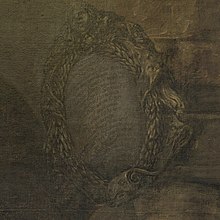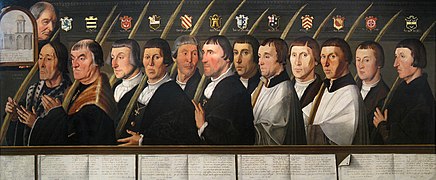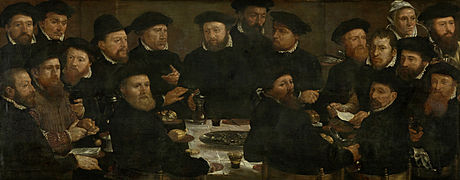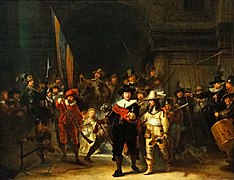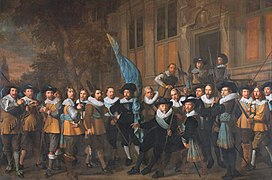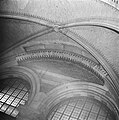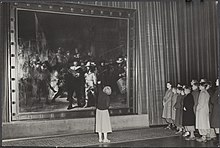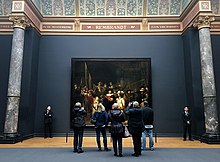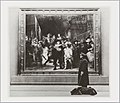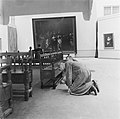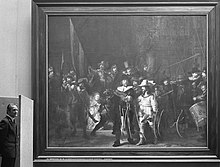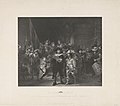The night watch

|
| The night watch |
|---|
| Rembrandt van Rijn , 1642 |
| Oil on canvas |
| 363 × 437 cm |
| Rijksmuseum Amsterdam |
The Night Watch ( Dutch De Nachtwacht ), exhibited in the Rijksmuseum Amsterdam on permanent loan from the City of Amsterdam with the subtitle Officers and other riflemen of District II in Amsterdam, under the leadership of Captain Frans Banninck Cocq and Lieutenant Willem van Ruytenburch, known as 'The Night Watch' , is a painting by the Dutch painter Rembrandt van Rijn . The work for the Amsterdam Rifle Guild, completed in 1642, is considered to be Rembrandt's main work, the authenticity of which has never been questioned due to the thorough documentation of the provenance and numerous documents and reports that have been handed down. It is also a highlight of the genre of Dutch group portraits and marksmen's plays. The Night Watch is not only one of the most significant objects of the Netherlands' national cultural heritage, but one of the most famous paintings in the world. As such, it has been an object of art historical research for generations, which has worked on the painting as thoroughly as few works of art.
description
presentation
The depicted scene is the gathering of a group of 31 people, mostly recognizable as soldiers because of their clothing or armament, who has gathered in front of a building made of large stone blocks with a staircase made up of several steps. This building has a monumental archway flanked by columns a little to the left of the center of the picture - in the original state of the painting much closer to the center. The right part of the building has a window on the first floor, on the right edge of the picture a wall or part of the building protrudes to the front. At the left edge of the picture there was a railing in its original state and to the left of it a bridge on which several people stood. Two soldiers, a child's head protruding just a little over the bridge's parapet, and most of the bridge were removed around 1715. Today, only part of the railing can be seen in the depiction.
The figure program still includes 31 people who, with a few exceptions, are recognizable as shooters, pikemen and officers. The clothes of the shooters depicted are inconsistent, and uniforms are only partially recognizable. In the foreground and in the center of the picture is a dark purple, almost black, dressed captain with a white millstone collar , red, gold-embroidered sash and black hat, who seems to be moving with a small step towards the viewer. In his right hand he is holding an officer's baton and a glove, with his left hand he points forward. To his right stands the lieutenant of the company, who is obviously receiving an order from his captain. Like the captain, he stands in bright light, he wears pale yellow clothes with a feathered hat, gauntlet boots of the same color and a white sash. He is armed with a collar and a partisan , and he too seems to be moving half a step forward.
The image plane behind the two officers is dominated by three riflemen, a musketeer in red clothes and with a red feathered hat and white millstone collar, on whose belt there are numerous powder bottles. He's just pouring powder into the barrel of his musket. To the right of him, almost completely covered by the captain, stands a musketeer who is turned with a long lunge to the right. He has just fired a shot to the top right so that the powder smoke forms a cloud behind the lieutenant's head. Immediately to the right behind the lieutenant is a helmeted third musketeer after firing a shot, who is just blowing the remains of the burned powder from the powder pan of his weapon.
The next image level to the rear shows two splendidly dressed girls between the first and second named musketeers, of which the smaller one is largely covered and the other is emphasized by a strong incidence of light. A dead chicken hangs from his belt and a small piece of a wheel lock pistol is visible. To the left of the red-clad musketeer with the powder bottle, a little boy (or a small man) with a helmet and a large powder horn runs in front of his stomach along the railing to the left.
The background of the picture is dominated by the flag bearer standing under the archway, holding up a blue-yellow-blue-yellow striped flag. On the left edge of the picture sits an armored and helmeted soldier with a halberd on the parapet of the bridge, who, despite the figures of two soldiers and a child originally painted behind him (i.e. closer to the picture edge), completes the depiction to the left. Similarly, a black-clad sergeant with a white millstone collar and a halberd, who is talking to a helmeted rifleman and pointing to the center of the picture, and a drummer in green, who looks at the viewer and is barked at by a medium-sized gray dog, create a border or frame right. In addition to these actors, a number of other figures are shown in the background, which are the two shield-bearers to protect the standard-bearer, a sergeant and a number of pikemen.
Figure program
The picture on the right is a copy in oil on wood by Gerrit Lundens (1622–1683) probably painted before 1653; it is on permanent loan from the London National Gallery in the Rijksmuseum Amsterdam. The white lines drawn are three of the cut lines to reduce the size of the original from 1715, with which three figures were removed from the left margin.
The group picture contains sixteen images of riflemen from District II of Amsterdam, who paid various amounts of money for their depiction, a total of 1,600 guilders. They are considered to be the main characters and are named with two other shooters on the shield that was only painted around 1653, after the copy was made, above the column to the right of the archway. In addition, Rembrandt painted sixteen secondary characters who perform different functions in the character program. Some of them are company riflemen who could not afford to contribute to a portrait and were therefore not shown in an identifiable manner. They were needed to achieve the desired company strength. Other secondary characters serve to increase the drama or are allegorical representations. With this addition of numerous extras to the group portrait, Rembrandt breaks a tradition of the Dutch archery, which until then was limited to the representation of paying customers.
Rembrandt shows the figures in clothes, helmets and weapons that have no contemporary models. The helmets of some riflemen are similar to that of Rembrandt's Bellona from 1633, but also to those of the barrel riflemen in Jacob de Gheyn's Wapenhandelinghe from 1607. However, this inconsistent representation of the figures is not necessarily an expression of artistic freedom. Rather, many members of the vigilante groups used the public appearance to present themselves in extravagant clothing. The Dutch author Caspar van Baerle described the solemn entry of Maria de 'Medici into the city of Amsterdam in 1638 and remarked about the numerous shooters that some had dressed up at their own discretion and others had armored themselves from head to toe .
The names of the protagonists are recorded on the original of the night watch above the center of the picture on a sign on the column: Frans Banning Cocq / heer van Purmerlant en Ilpendam / Capiteijn / Willem van Ruijtenburch van Vlaerding / heer van Vlaerdingen Leutenant / Jan Visscher Cornelisen vaendrich / Rombout Kemp Sergeant / Reijnier Engelen Sergeant / Barent Harmansen / Jan Adriaensen Keyser / Elbert Willemsen / Jan Clasen Leijdeckers / Jan Ockersen / Jan Pietersen bronchorst / Harman Iacobsen wormskerck / Jacob Dircksen de Roy / Jan vander heede / walich Schellingwou / Jan van Brugys / Claes / Paulus Schoonhoven . The figures can only be identified in the painting by the attributes of their rank and by evaluating known biographical data.
- Jan Brughman, blond musketeer with hat in hand (removed in 1715)
- Jacob Dircksz. de Roy, archer with a wide-brimmed black hat (removed in 1715)
- Secondary character, small child, only the head visible (1715 removed)
- Sergeant Reijnier Jansz. Angels with armor, winged helmet and halberd
- Secondary character, little boy with powder horn and oversized helmet, walking to the left
- Secondary character, soldier, face almost completely covered by halberd and musket
- Jan Pietersz. Bronckhorst, security guard with helmet
- Herman Jacobsz. Wormskerck with shield, sword, millstone collar and wide-brimmed hat
- Elbert Willemsz. Swedenrijck, musketeer with a feathered helmet
- Jan Aertsz. van der Heede, musketeer in red, loading his weapon
- Secondary character, face of a man, almost completely covered
- Minor character, little girl next to the musketeer's left arm in red
- Secondary figure, covered soldier, only helmet visible
- Secondary character, blonde girl, splendidly dressed, with a chicken and a wheellock pistol on her belt
- Ensign Jan Visscher Cornelisen (or Jan Cornelisz. Visscher), standard bearer
- Secondary character, undercover soldier walking to the right, has just fired a shot
- Secondary figure, only the upper half of the face recognizable, possibly a self-portrait of Rembrandt
- Claes van Cruijsbergen, shield bearer with helmet and collar in the background
- Minor character, face of a man
- Captain Frans Banninck Cocq, in black, with a red sash and an officer's stick in his right hand
- Jan Ockersen, pikeman with armor and top hat
- Minor character, face of a man
- Jan Adriaensz Keijser, sword bearer right behind Captain Banninck Cocq
- Walich Schellingwou, pikeman with armor and helmet on the column
- Lieutenant Willem van Ruytenburgh, with partisan and collar , in yellow with a white sash
- Jan Claesz. Leijdeckers, musketeer in red, blows burnt powder off the pan of his musket
- Barent Hermansz. Bolham, armored pikeman with feathered black beret
- Secondary character, face of a man, almost covered by hand
- Secondary figure, a soldier with a feathered hat, almost covered by an outstretched arm
- Minor character, face of a man
- Sergeant Rombout Kemp, with a wide-brimmed black hat, an outstretched right arm and a halberd over his left shoulder
- Secondary character, face of a man, almost completely covered
- Jacob Jorisz., Drummer
- Paulus Harmensz. Schoonhoven, with a helmet and a red scarf
Self-portrait of Rembrandt
Between the standard bearer and the shield bearer with a helmet and collar standing to his right, the nose and right eye of a man with a painter's beret can be seen. Identifying a person seems impossible because the figure is almost completely obscured. Nevertheless, the fragment has been repeatedly interpreted as a self-portrait of Rembrandt, first by the Dutch art historian Wilhelm Martin . A large number of self-portraits by Rembrandt have come down to us that no other important painter has done. It was common for Rembrandt, as for other painters of his time, to incorporate his own portrait in his paintings. The assumption that there is also a self-portrait with the figure of the night watch is based on the depiction with a painter's beret, which Rembrandt also chose on other occasions. As an example, Martin cites the portrait of Rembrandt with beret and two gold chains , which was painted around 1640 and is today attributed to Ferdinand Bol , which may have been based on a lost self-portrait of Rembrandt. The painting The Bittern Hunter in the Gemäldegalerie Alte Meister and an etching showing a study of a tree and a self-portrait of Rembrandt, which is almost identical in detail, are certainly by Rembrandt himself .
Reason, place and time of installation

Because of the central bust of the French royal mother Maria de 'Medici, there is no dispute about the connection with their triumphant reception in Amsterdam, depicted in Joachim von Sandrart's Riflemen of the Company of Captain Cornelis Bicker and Lieutenant Frederick van Banchem . According to the Dutch art historians Jan Six and Frederik Schmidt Degener , the night watch - like the other riflemen's pictures in the Great Hall of Kloveniersdoelen - shows the moment on August 31, 1638 when the company set off for the ceremonial reception of the Medicis. The location of the action is therefore in front of the rifle house, the Kloveniersdoelen, built a few years earlier in the Nieuwe Doelenstraat .
This representation was questioned with the reference that neither Captain Frans Banninck Cocq nor Lieutenant Willem van Ruytenburgh were already officers of the rifle company at the time of the visit.
Due to the already dark depiction, which Rembrandt's contemporaries noticed, and the darkening of the painting, the misleading name Night Watch was given at a later date . In art historical research, the shown departure of the company is mostly set at lunchtime. The lack of sharp contrasts that are typical for candlelight or lantern light speak against a night piece. However, the light falling on the painting is also unnatural for daylight. Rembrandt created his own light structure for the night watch , which does not show the reality of a specific time of day, but an illusion.
Interpretation and symbolism
While a regent portrait and five other rifle pieces are based on earlier works in the Kloveniersdoelen's decoration program, Rembrandt dares to depict numerous individual actions with the Night Watch , which put the individual portraits aside beyond recognition for the company as a whole. Even the number of people shown is difficult to determine, as many of the minor characters are only shown in small excerpts. Exceptions are the officers, of whom the arrangement in the image and body language places Captain Frans Banninck Cocq higher than the lieutenant and the latter over all other musketeers. In addition, the earlier group portraits were distinguished by the fact that the figures direct their gaze at the viewer, thereby including him and subordinating themselves to him. Rembrandt broke with this tradition in the night watch, only Frans Banninck Cocq, the older of the two girls and the drummer on the right edge of the picture look at the viewer, while the other figures look at each other or concentrate on one activity. Samuel van Hoogstraten was Rembrandt's pupil on the Night Watch . Decades later, in his introduction to the High School of Painting , he formulated the requirement for a successful group portrait, which the Night Watch corresponded to like no other painting of his time: Pay attention to a pleasant staggering, i.e. a clever but apparently random arrangement of the figures so that you they could not behead everyone with one blow, so to speak - as in some rifle pieces ( Dutch Neem een aerdige sprong waer, dat is een welkunstige, maer in schijn ongemaekte plaetsing uwer beelden: op dat menze niet, bij wijze van spreeken, al te gelijk (as in sommige Doelstukken) de hoofden kan afslaen ).
An allegorical function is ascribed to a number of pictorial elements of the night watch , of which only a few could be deciphered. Both the claws of the chicken and the wheellock pistol on the sutler's belt are symbols of Amsterdam rifle shooters, which also appear in other paintings. Examples are the early rifle piece, Seventeen Riflemen of the Rotte F des Kloveniersdoelen, painted in 1557 by an unknown master with a wheellock pistol in the center of the foreground, and the Regent's piece painted by Govaert Flinck in 1642 for the Great Hall of Kloveniersdoelen, on which a claw is contained in a frame on the right . The little girls themselves are to be seen as sutlers, who were sometimes scaled down in depictions of the 16th century military or depicted as children. This reduction in size was a means of emphasizing their minor importance compared to soldiers, and especially officers. This also applies to the boy with the powder horn running to the left, whose appearance in a picture of reality is hardly imaginable.
In the Night Watch, Rembrandt painted three musketeers in different stages of shooting training, loading, shooting and blowing off the powder residue from the pan. In doing so, Rembrandt evidently made use of Jakob de Gheyns II's weapon book, published in 1607 ( Wapenhandelinghe van Roers, Musquetten ende Spiessen , German: weapon knowledge of pipes , muskets and skewers ). The depiction of three musketeers in the midst of a group of people with their weapons and even shooting is just as unrealistic as its details, for example the pouring of powder into the barrel of a free-hand-held musket by the red-clad musketeer on the left. Contemporary muskets were too heavy for that, and de Gheyn correctly shows the loading of a musket propped on the ground. Overall, the figures of the three musketeers are not to be seen as a representation of a real event, but as an allegory of archery.
The architectural elements with the archway and the heavy, horizontal cornice were also trimmed in 1715. As a result, they lost part of their function as a framework that testified to calm and dignified majesty. The archway together with the flag was not to be seen as an arbitrary background, but as a triumphal arch and a symbol of the defensive and victorious city of Amsterdam.
Refuted the interpretation Frans Banninck Cocq applies embodied on the vigil the hero of Joost van den Vondel's tragedy Gijsbrecht van Aemstel , which premiered in January 1638 in Amsterdam and was very popular in their time.
title

Neither Rembrandt nor the Amsterdam guild of rifle shooters has survived a contemporary title for the Night's Watch . In the 17th century it was not customary to give paintings a special name. The titles assigned to the works today are mostly derived from the visual representation or derived from documents that were handed down by the artists or their clients. In many cases, only an emergency name can be assigned if a person portrayed or a motif cannot be identified. An example of the difficulty of giving a work an appropriate title is Rembrandt's history painting, painted around 1626, with a self-portrait of the painter . It was often the subject of considerations in art historical research, but there is still no convincing explanation of the depicted motif and no generally accepted title.
The Dutch diplomat Gerrit Schaep returned to Amsterdam in February 1653 and compiled a list of the paintings in the three rifle houses, preserved in the Amsterdam city archives. He performs the night watch with the six other pictures of the Great Hall of Kloveniersdoelen, where he only gives the names of the officers: Likewise next following Frans Banning Cock Hpt., And Willem van Ruytenburg, Lt., painted by Rembrandt in 1642 ( Dutch Ibid. Daernaest aenvolgende Frans Banning Cock Cap n , end Willem van Ruytenburg, Lut., Portrayed van Rembrand a o 1642 ). The shape The company of Captain X and Lieutenant Y, painted by Z, was for centuries and is still a common form of designation for Dutch rifle pieces.
Frans Banninck Cock left a two-volume family album that contains a water-colored copy of the Night Watch , probably painted by Jacob Colijns after the copy by Gerhard Lundens. Opposite the watercolor is the following description: Sketch of the painting in the Great Hall of the Schützenhaus, on which the young Herr von Purmerland as captain gives his lieutenant, Herr von Vlaardingen, the marching orders for his company ( Dutch: Schets van de Schilderije op de groote Sael van de Cleveniers Doelen daerinne de Jonge Heer van Purmerlandt as Capiteijn, geeft last aen zijnen Lieutenant, de Heer van Vlaerdingen, om syn Compaignie Burgers te doen marcheren ). It is not certain that this text was written by Frans Banninck Cocq, as a descendant of a descendant made some manipulations on his family album. Regardless of this, the description is the oldest recorded interpretation of the painting. It also served as a template for recent attempts to get away from the objectively false title The Night Watch.
The term Nachtwache was first used in 1781 by the English painter Joshua Reynolds , who, however, also doubted Rembrandt's authorship in favor of Ferdinand Bol and was guided by the aging of the varnish and the soiling of the painting by dust and soot. In addition, the vigilante groups of the late 18th century were actually only used as night watch. Since then, the title Die Nachtwache has prevailed at the expense of other suggestions, although the depicted scene certainly does not take place at night. An anecdote from the 19th century justifies the title The Night Watch with the gloomy appearance of the painting. This, in turn, is due to the fact that the painting was hidden under the floors of the Trippenhuis during the French occupation, where it was so dirty that Napoleon's greed for it vanished.
The Dutch writer Everhardus Johannes Potgieter , editor of the literary magazine De Gids , preferred the title Vogelschießen ( Dutch Vogelschieten ), while the art historian Frederik Schmidt Degener has always advocated the shooter lift ( Dutch Schuttersoptocht ).
In the art-historical literature, the painting was given different titles. Wilhelm von Bode named the painting in 1900 in the fourth volume of his catalog The Excerpt from Frans Banning Cocq's Rifle Company , with the addition incorrectly called "The Night Watch" ( English The march out of Frans Banning Cocq's company of the civic guard. Erroneously called "The Night Watch." " ). In his catalog raisonné published in 1915, Cornelis Hofstede de Groot names the painting Excerpt from the Rifle Company of Captain Frans Banning Cocq , with the reference known as "The Night Watch" . Abraham Bredius named it in 1935 in a caption of his catalog raisonné The Riflemen under Captain Frans Banning Cocq ( Dutch: Het uitrukken van de schutterij onder kapitein Frans Banning Cocq en Luitenant Willem van Ruijtenburg ), but otherwise used the term Die Nachtwache . Horst Gerson chose the caption Der Schützenaufmarsch of the company of Captain Frans Banning Cocq and his lieutenant Willem van Ruytenburch, popularly known as "The Night Watch" , in his catalog raisonné of Rembrandt's 1969 . In the catalog section, however, he chose the title The Rifle Company of Captain Frans Banning Cocq ("The Night Watch") . In scientific literature, the formal designation for the night watch, as for most Dutch rifle pieces, has become established after the officers depicted, i.e. portrait of the company of Captain Frans Banninck Cocq and Lieutenant Willem van Ruytenburgh or similar titles in numerous variants. In addition, the term Die Nachtwache is usually mentioned as a trivial name, and is also used in scientific texts as an alternative to repeatedly specifying the rather long title.
The Rijksmuseum Amsterdam as the exhibiting museum names the painting The Night Watch ( Dutch De Nachtwacht ) with the subtitle Officers and other riflemen of District II in Amsterdam, led by Captain Frans Banninck Cocq and Lieutenant Willem van Ruytenburch, known as 'The Night Watch' ( Dutch Officieren en other schutters van wijk II in Amsterdam, onder suffering van kapitein Frans Banninck Cocq en luitenant Willem van Ruytenburgh, known as 'De Nachtwacht' ). The Amsterdam municipality, the owner of the painting, simply calls it The Night Watch .
background
Dutch rifle guilds up to the 17th century
The Amsterdam Golden Age vigilantes - archers, crossbowmen and arquebusiers or musketeers - were subordinate to the rulers of Amsterdam . Its original and primary task was to defend the city against external enemies. In addition, there was the fight against internal unrest, but this was not necessarily done reliably by the shooters, who often belonged to one of the warring parties. Theoretically, all adult residents of the city were required to serve in the vigilante until they were sixty. Since the members of the vigilante group had to take care of their own weapons, the poorer sections of the population were practically excluded. The members of the rifle companies mostly belonged to the middle class and the officers to the upper class. In 1620 Amsterdam was divided into twenty districts, each forming a defense district with its own rifle companies. For their members there was a residence obligation, only officers were exceptionally allowed to live outside the district of their company. Most of the people depicted on the Night Watch are musketeers, pikemen, sergeants and officers of the Amsterdam Second District Vigilante. This was in the west of the city, immediately south of the Nieuwe Kerk between Damrak and Singel .
Dutch group portraits and marksmen's pieces
As a representative of the Vienna School of Art History, Alois Riedl provided a formalistic representation of the Dutch group portrait with his work The Dutch Group Portrait , published in 1902 . He saw individual portraits as a prerequisite for group portraits, as they have been painted in Holland with identifiable portraits of donors since the early 15th century. The fate of the earthly remains of Johannes the Elder, painted by Geertgen tot Sint Jans after 1484 . Täufers is considered the oldest surviving Dutch group portrait, it shows the members of the Haarlem Johanniterkommende in the middle distance and still uses the traditional form of the history picture to create an external reason for the group's appearance. Later group portraits with a religious background are the portraits of the Haarlem and Utrecht drivers painted by Jan van Scorel between 1525 and 1530 . Von Scorel now depicts those portrayed in a densely staggered manner in an only sparingly designed background, so that the viewer's attention unrestrictedly goes to the portrayed people.
The oldest known Dutch shooting piece has a similar shape. It is from Dirck Jacobsz around 1529 . commissioned by the Amsterdam Kloveniersdoelen, three-part picture of the Amsterdam rifle shooters with 31 portraits. The portraits are placed equally next to each other and on two floors, and nothing but the different gestures of the hands brings an action to the panels that could distract from the portraits. The framework in which the represented members of the rifle guild find themselves is the common task, the defense of the city, and the community founded for this purpose. One from Dirck Barendsz. painted Schützenstück from 1566, the banquet of 18 Amsterdam riflemen , already with its dissolution of the strict geometric arrangement of the individual portraits and the depiction of a meal with bread and fish, indicates the later development, in which the portraits are again embedded in a plot. The 1596 by Pieter Isaacsz. Rifle company painted for Kloveniersdoelen by Captain Jacob Hoynck and Lieutenant Wijbrand Appelman shows the use of the depth of space with the architectural elements of the background and the staggering of the figures. In addition, the figures are more individualized than before in their clothing, the attributes of their rank and their weapons. In 1625 Werner van den Valckert painted the riflemen of Albert Burgh's company , in which the individualization and the dissolution of order are still more advanced, but still appear static compared to the rifle pieces painted after 1640. The Dutch group portrait of the 17th century reached an artistic climax with the Night Watch . A few years later, in 1648, Bartholomeus van der Helst painted another outstanding work with the Rifle's Meal to celebrate the Peace of Münster , and in 1650 the last large-format followed with the Rifle's Meal with Colonel Jan van de Poll and Captain Gijsbert van de Poll by Johannes Spilberg Shooter portrait. Other forms of Dutch portrait painting such as the regent portrait and anatomical and other lectures continued to exist.
- Dutch group portraits
- Geertgen dead Sint Jans: Fate of the earthly remains of Johannes d. Täufers , after 1484, oil on oak, 172 × 139 cm (trimmed above), Kunsthistorisches Museum , Vienna
- Jan van Scorel: Twelve members of the Haarlem Brotherhood of Jerusalem Drivers, 1528 to 1530, oil on panel, 114 × 275.7 cm, Frans Hals Museum , Haarlem
- Dirck Jacobsz .: A group of riflemen des Kloveniersdoelen , 1529, oil on oak, in three parts 120 × 78 cm, 122 × 340 cm and 120 × 78 cm, Rijksmuseum Amsterdam
- Dirck Barendsz .: Banquet of 18 Amsterdam Riflemen , 1566, oil on panel, 120 × 295 cm, Rijksmuseum Amsterdam
- Pieter Isaacsz. Rifle company of Captain Jacob Hoynck and Lieutenant Wijbrand Appelman , 1596, oil on canvas, 171 × 502 cm, Amsterdam Museum
- Werner van den Valckert: Riflemen of the Albert Burgh Company , 1625, oil on wood, 169.5 × 270 cm, Rijksmuseum Amsterdam
The picture program of the large hall of the Kloveniersdoelen

Between 1640 and 1645, seven large-format paintings were commissioned from various painters for the Great Hall on the upper floor of the gunmen's headquarters, the Kloveniersdoelen. It was a portrait of the regent and six marksmen's pieces, including The Night Watch , which are now in the Rijksmuseum Amsterdam. The portraits of the riflemen on group portraits had to be paid for themselves, even if the paintings remained with the rifle guild.
- Joachim von Sandrart : Riflemen in the company of Captain Cornelis Bicker and Lieutenant Frederick van Banchem , 1640, oil on canvas, 343 × 258 cm.
- Govaert Flinck : Die Regenten des Kloveniersdoelen , 1642, oil on canvas, 203 × 278 cm. Around the table sit the four regents Albert Coenraetsz. Burgh, Jan Claesz. Vlooswijck, Pieter Reael and Jacob Willekens. They are served by the Kloveniersdoelen innkeeper, Jacob Pietersz Nachtglas, who hands them a silver buffalo horn as a guild goblet. On the right of the wall there is a chicken claw in a frame as a symbol of the cloveniere.
- Govaert Flinck: The company of Captain Albert Bas and Lieutenant Lucas Conijn , 1645, oil on canvas, 347 × 244 cm
- Rembrandt van Rijn: The Night Watch , 1642, oil on canvas, 379.5 × 453.5 cm (cropped on all sides in 1715)
- Nicolaes Eliasz. Pickenoy : Captain Jan Cleasz's company. Vlooswijck and Lieutenant Gerrit Hudde , 1642, oil on canvas, 340 × 527 cm
- Jacob Adriaensz. Backer : The company of Cornelis de Graeff and Lieutenant Hendrik Lauwrensz. , 1642, oil on canvas, 367 × 511 cm
- Bartholomeus van der Helst : Captain Roelof Bicker's company , 1640 to 1643, oil on canvas, 235 × 750 cm
- Front wall, opposite the entrance, above and next to the fireplace
- Right side, opposite the windows
- Wall to the city tower, above the large chimney
reception
Client
For generations the myth has run through art historical literature that the clients, i.e. the portrayed shooters, with the exception of Frans Banninck Cocqs, were dissatisfied with their portrayal. This dissatisfaction was also the reason that Rembrandt received significantly fewer portraits after 1642 and ultimately ran into economic difficulties that threatened his existence. In fact, only Banninck Cocq is known to have two copies of the Night's Watch painted for himself . Other portrayed shooters were later portrayed, but by different painters. The decline in Rembrandt's productivity can easily be justified with a crisis after the death of Rembrandt's wife Saskia shortly before the end of the night watch , with the high prices that Rembrandt demanded, and with a changed taste of the time, which is now lighter than that of the " somber “Rembrandt preferred. The myth of the discontented rifle company has not yet been convincingly proven.
Art history
The painter, Rembrandt pupil and art theorist Samuel van Hoogstraten noted in 1678 at the Night Watch that many believed that Rembrandt had worked more on the complete works than on the individual portraits he was commissioned to do. He himself was full of praise for the work, next to which everyone else (in Kloveniersdoelen) looked like a couple of playing cards . He just wished for more light in it.
The British painter Joshua Reynolds criticized the Night Watch in 1781: I am so far from accepting the great reputation of the painting as legitimate that I was difficult to convince myself that it was painted by Rembrandt; it seems to me to have more of the yellowish style of Bol. The name Rembrandt is certainly on it, with the year 1642. It looks badly damaged, but what is preserved seems to have been poorly painted ( English So far, indeed, am I from thinking that this last picture deserves its great reputation, that it was with difficulty I could persuade myself that it was painted by Rembrandt; it seemed to me to have more of the yellow manner of Boll. The name of Rembrandt, however, is certainly upon it, with the date, 1642. It appears to have been much damaged, but what remains seems to be painted in a poor manner ).
The art historian Alois Riegl saw the reduction of the rifle piece to the two officers in front of a background filled with other people as a destruction of the coordination inherent in the group portrait and thus the group portrait in general. According to Riegl, that was also the reason for the contemporary criticism of the uninvolved Amsterdam audience. Riegl referred to the rifle piece Die Firma by Captain Roelof Bicker by Bartholomeus van der Helst, which was completed only a year after the night watch and which was also part of the Kloveniersdoelen's decoration program, because of its return to traditional forms - the bright light, the coordination of the figures and you as the viewer directed look - as a painted criticism of the night watch .
During the 19th century, the growing national awareness in the Netherlands led to a new evaluation. One of the first voices in the new pitch came from the writer and literary critic Conrad Busken Huet : Rembrandt's anatomical lecture, his excerpt from the shooting range, are poems. (...) He saw ordinary people and ordinary things in a special way. His art is the ongoing application of a process of glorification. Whether you let him paint Saskia, Hendrickje , a professor of surgery, an officer in the Amsterdam vigilante or a rabbi in his study, he turns them into supernatural beings (Dutch: Rembrand's Anatomische Les, zijn Uittogt naar het schietterrein, zijn poems. (. ..) De Gewone Menschen en de Gewone things zag hij op eene bijzondere wijs. Zijne Kunst is de aanhoudende toepassing van een devastating process. Hetzij gij hem Saskia te schilderen geeft, Hendrikje Jaghers, een professor in de chirurgie, een officier der Amsterdamsche schutterij een rabbijn in eene studeerkamer, hij maakt er bovenaardsche wezens van ).
But the Dutch cultural historian Johan Huizinga still found critical words for the night watch in a lecture in Cologne in 1932 : All the treasures of light and color in this wonderful picture cannot hide the fact that here a will has failed, that here a heroic deed of the great Stiles did not succeed .
The art historian Christian Tümpel wrote in 1977:
“The whole picture, including the composition, is assigned to this idea of the order to be achieved. The two officers approach the middle. Many spears and rifles, in their rhombic arrangement, already hint at the principle of order in military exercises, as the textbooks and illustrations of the time show. The tension between 'already now' and 'not yet' is what makes this composition so special. "
The night watch as a national cultural asset
During his lifetime and far beyond, Rembrandt stood in the shadow of his contemporary Bartholomeus van der Helst , and in the 17th and 18th centuries his works were rejected by art theorists even though they were already coveted by art collectors. In the 19th century, it was not Rembrandt but the Antwerp Peter Paul Rubens who was considered the most important painter in the Netherlands. When Belgium became independent after the Belgian Revolution of 1830, a new national painter had to be found for the Netherlands, which led to a new appreciation of the Night Watch and the work of Rembrandt as a whole. A few years later a first catalog raisonné of his paintings was published, in 1853 a Rembrandt monument was inaugurated on the Amsterdam Botermarkt as an expression of the awakened national consciousness and in 1876 the square was renamed Rembrandtplein . As the largest surviving painting by Rembrandt and certainly also because of the outstanding representation of the well-fortified Amsterdam bourgeoisie among other rifle pieces from the 17th century, the Night Watch also became a symbol of national importance. When the painting was brought to the newly built Rijksmuseum Amsterdam at the beginning of July 1885, the 24 porters sang Wien Neêrlands Bloed , the national anthem of the Netherlands at the time.
The rifle company as a homosocial group
At the end of the 20th and beginning of the 21st century, the question was raised whether the night watch rifle company was a homosocial group ( an interpretation of the night watch as homoerotic pastoral ). A homoerotic relationship was ascribed to the officers Banninck Cocq and Willem van Ruytenburgh, which was mainly based on the shadow of Banninck Cocq's hand pointing to van Ruytenburgh's genital area.
Provenance and exhibition locations
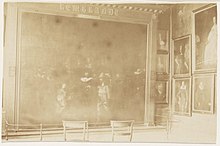
owner
It was the belief of the people depicted in 17th century Dutch group portraits that the portraits they paid for belonged to them too. In practice, this was of no importance, the night watch was in fact the property of the rifle guild. At an unknown point in time in the 18th or 19th century, ownership passed from the rifle guild to the city of Amsterdam. The city is still the owner of the painting, which is on permanent loan to the Rijksmuseum.
Suspension 1642 to 1945
Rembrandt painted his painting for the hanging in the great hall of Kloveniersdoelen, the headquarters of the Amsterdam rifle shooters, where it hung as part of a decoration program on the long side of the hall opposite the windows.
In 1715 the night watch was moved from Kloveniersdoelen to the Paleis op de Dam on Amsterdam's Dam , which at the time served as the town hall. In order to be hung between two doors in a hall on the first floor, the painting was cut on all four sides.
In February or March 1808, by order of the city administration , the night watch was temporarily brought to the Trippenhuis at Kloveniersburgwal 29, one half of which was inhabited by the art dealer Cornelis Sebille Roos (1754-1820) as director of the Rijksmuseum Amsterdam. In August this year, the painting was returned to the Palace on Dam, which at that time by that of Napoleon Bonaparte to the Dutch Royal appointed Lodewijk Napoleon as Dutch National Museum ( Dutch Groot Hollandsch Museum was provided). In 1815, after the liberation of the Netherlands, the night watch returned to the second floor of the Trippenhuis, which now housed the Rijksmuseum Amsterdam.
In 1885 the night watch was brought to the newly built Rijksmuseum Amsterdam and hung at the end of the “gallery of honor”. The Dutch art historian Henk van Os , director of the Rijksmuseum from 1989 to 1996, called the Rijksmuseum, designed by Pierre Cuypers , a cathedral , with the Night Watch as the most important work on the main altar. The Rijksmuseum Amsterdam opened on July 13, 1885. From the beginning, however, there were complaints from visitors that the lighting in the Trippenhuis had been better. In response, a dark velvet canopy was set up in front of the night watch, allowing visitors to view the painting from the shadows.
From September to November 1898 the Night Watch was presented as part of a large Rembrandt exhibition in the Stedelijk Museum . The wooden crate with the painting was transported by numerous carriers via Museumsplein and Paulus Potterstraat, where the crate was hoisted through a large window on the first floor of the museum. The lighting in the Stedelijk Museum, which was changed compared to the location in the Rijksmuseum, led to a greatly changed perception of the colors, which experts hailed as the rediscovery of Rembrandt . In contrast, the return to the Rijksmuseum was perceived as a funeral : "The wonderful red musketeer was put into a dirty, dirty-red costume, he no longer exists". In the period that followed, the appropriate lighting for the painting was discussed continuously and intensively.
Ultimately, the Rijksmuseum was given an annex, again designed by Cuypers, in 1906, in which the night watch was no longer illuminated from above, but from the side. However, the night watch was then exhibited in an adjoining room. At the end of the 1920s, the painting was brought back to the night watch room, but hung on a side wall with lateral light.
- The night watch was suspended until 1939
Refugee during World War II
In fear of war, preparations were made as early as the 1930s to protect Dutch cultural assets. In 1934, an elongated opening was added to the floor in the night watch room, the "night watch slot", which allowed the painting to be lowered to street level. In 1938 Willem Sandberg , curator of the Museum of Modern Art and after the war director of the Stedelijk Museum in Amsterdam, and Johan Brouwer , a Hispanist and later resistance fighter against the German occupiers, traveled to Spain to find out about their experiences in protecting cultural assets of the Spanish Civil War . On September 4, 1939, a few days after the German invasion of Poland , the night watch was first brought to Radboud Castle at the port of Medemblik in a glass transport car and stowed there in the knight's hall. From January 1 to April 10, 1940, a shelter was built in the Geversduin near Castricum . On May 13th and 14th, during the invasion of the German Wehrmacht , the painting was brought to this shelter by order of Frederik Schmidt Degener, director of the Rijksmuseum. It turned out that the painting did not fit through the entrance because of its size. So it was removed from the frame outside and rolled up on a spindle with the picture facing outwards. According to other sources, the painting arrived already rolled up on a cylinder that was too large to be stored and required a change to a smaller cylinder. The director of the Stedelijk Museum, David Röell , and his curator Wilhelm Sandberg moved into a barrack near the shelter.
During the following months, a larger shelter was built in the nearby Heemskerk , to which the night watch was also brought on March 21, 1941 . In 1942 the coastal areas were affected by the work to build the Atlantic Wall . Therefore, the night watch was relocated for the last time on March 24, 1942, in a tunnel in Sint Pietersberg near Maastricht . After the surrender of the German occupiers, the Night Watch was able to return to Amsterdam in June 1945. Since the Dutch inland waterways were partially impassable, the return transport took place via Belgium. That was the only time the Night Watch had left the Netherlands.
In connection with the evacuation of the Night Watch and other Dutch cultural assets, the legend arose that it was possible to hide the art treasures that were brought into shelters from the German occupation authorities. In fact, the Germans knew very well where the night watch was housed. The accommodation was probably thought to be safe and the cultural assets were only wanted after the end of the war. A form filled out on August 12, 1940 by the Reich Commissioner for the Netherlands reads:
“ The Reich Commissioner and the Wehrmacht Commander in Chief of the Netherlands are aware that art treasures from the Reichsmuseum and the City Museum in Amsterdam are in safekeeping in the protective cellar in Castricum.
No one, with the exception of the personnel responsible for guarding, is allowed to examine the building and the boxes and folders in it, or to continue any of its contents, without the special permission of the Reich Commissioner or, as far as it appears necessary for military purposes, of the Wehrmacht commander. "
- The night watch in World War II
Suspension since 1945
After their return, the night watch was hung in its old place in the night watch room, where from July to September 1945 it was the most important piece of the exhibition Weerzien der meesters in het Rijksmuseum (German: Reunion of the Old Masters in the Rijksmuseum ). As early as 1947, the painting had to leave the Rijksmuseum again and be taken to the Rijksmuseum for restoration because the painting was too big for the restoration workshop. On July 9, 1948, they were transported back via the streets around the museum.
After the restoration, the night watch was hung up again on the side of the night watch room. In 1984 the Rijksmuseum was renovated, in the course of which the condition of 1885 was largely to be restored. The night watch was hung in its original location so that it can be seen again at the end of the gallery of honor.
In 2003 the night watch left the night watch room for the third time on the occasion of the upcoming restoration of the Rijksmuseum. It was lowered through the night watch slot and transported via the adjacent streets to the south wing of the museum - the Philips wing - and presented there until the renovation work was completed. In April 2013 the return transport took place on the same route.
- Suspension since 1945
frame

It is possible that the night watch and the other paintings in the Kloveniersdoelen were fitted into the wall paneling without a frame. This was also given as the reason for the cartouche with the names of 18 musketeers, which was subsequently painted on around 1653. This assessment is, however, an unsubstantiated speculation; the strongly different formats of the paintings and their completion in different years speak against it. No details are known of the suspension in the Palais op de Dam either. The oldest tradition on this subject mentions a heavy frame that looked like a portal in 1854, on the upper edge of which Rembrandt's name was affixed in about thirty centimeters high broken capitals.
For the suspension in the Rijksmuseum Amsterdam, which opened in 1885, the architect of the museum building, Pierre Cuypers, also designed a new, wide frame with rectangular decorative fields for the night watch . On the lower edge was the two-line inscription Het korporaalschap van den kapitein Frans Banning Cock in capitals . During the exhibition at the Stedelijk Museum from September to November 1898, the painting was temporarily in a smooth frame, but was stretched back into the Cuypers frame on return. This was used until 1939 when the night watch was brought to a shelter due to the war.
After the Second World War and the restoration, the night watch was given a wide frame with a stepped profile, in which it was photographed in July 1945 by the Dutch photographer Emmy Andriesse and her colleague Charles Breijer . A photo in the Nationaal Archief from July 1952 shows the painting again in a Cuypers frame. In 1959, the night watch was provided with a 45 centimeter wide frame with a stepped profile that was in use until the 1975 stop. In the course of the subsequent restoration, a narrower, profiled frame with a width of only 19 centimeters was made, as the very wide frames preferred in the past were now perceived as annoying.
- The frame of the night watch
The Night Watch in July 1945, photo by Emmy Andriesse
The Night Watch in July 1945, photo by Charles Breijer
Damage and restorations
The vigil had in the four centuries of its existence be repeated restored to damage caused by the natural decay of the carrier material, accident or vandalism to fix. The suspension in the festival and event halls of Kloveniersdoelen and the Palais op den Dam exposed the night watch for almost two centuries to the constant risk of damage from weapons carried and by the festival.
The first documented and most serious damage to the painting occurred in 1715 when it was hung in the Amsterdam City Hall, today's Paleis op de Dam . At around 4.02 meters high and 5.10 meters wide, the painting was too big to be hung in the space provided between two doors. Therefore, strips were cut off on all sides, especially on the left edge, where three figures were removed. The surface of the painting was reduced by about twenty percent, the cut strips are not preserved. The original condition can only be ascertained through the two copies of the painting made before the reduction, especially the copy painted by Gerrit Lundens in the possession of the National Gallery in London.
As early as 1717, two years after the painting was severely cropped, the painter and restorer Jan van Dijk reported that it was in very poor condition. The numerous layers of varnish made the motif barely recognizable, and the trimmings on the lieutenant's yellow doublet were so impasto that you could rub nutmegs on it. Van Dijk also stated that the scene was bathed in strong sunlight. In 1715 and 1751 or 1752 the night watch was cleaned by van Dijk.
The decomposition of the canvas calls in today's opinion, the doubling of the vigil at intervals of about one hundred years to obtain a sound basis for the primer and paint. Nothing is known about the first doubling, which occurred in the 18th century. Günther Gensler (1803–1884) stated after his stay in Amsterdam in 1837 that the painter and picture cleaner Nicolaas Hopman (1794–1870) (Gensler writes Hogman ) later mounted the painting, which was very damaged during his visit, on a new canvas, among other things. Hopmann was a painter and worked as a private restorer for the Mauritshuis and the Rijksmuseum between 1841 and 1870 . Work on the night watch took place in 1851. In the past, doubling was done in such a way that a paper layer was first glued to the picture side with water-soluble adhesive. In the course of further treatment, she fixed the paint layer in place. Then organic glue was applied to the back of the canvas or, after its removal, to the back of the primer, the new canvas was placed on top and pressed onto the old canvas with a hot iron without bubbles. With this procedure it was essential to keep the iron in constant motion, otherwise it would have irrevocably left an impression on the painting. At the end of the procedure, the paper layer on the picture side was peeled off with lukewarm water. On the one hand, the process ensured the preservation of the painting, but also led to the leveling of the surface structure.
In 1889, Hopman's son Willem Anthonij Hopman (1828–1910), who also worked as a private restorer for the Mauritshuis and Rijksmuseum in the last quarter of the 19th century, carried out a cleaning and refreshment according to Max von Pettenkofer's method . The surface of the painting was first rubbed with ethanol to remove deposits. The paint layer was then exposed to a combination of copaiva balsam and ethanol vapors, which smooths the cracked, brittle or dull varnish and makes the colors bright again. In 1896, again by Hopman, cleaning with turpentine was carried out. In 1906, Hendrik Heydenrijk (around 1848–1918), an employee who had taken over Hopman's workshop in 1900, renewed the varnish.
On January 13, 1911, the 28-year-old unemployed seaman Roelof Antoon Sigrist scratched the layer of varnish in the center of the painting with a shoemaker's knife, without damaging the layer of paint. The damage to the varnish was only minor and could be repaired without leaving any permanent marks. Sigrist stated that he wanted to take revenge on the state with his act. He was sentenced to one year in prison.
After the end of the Second World War, the condition of the night watch , which had been stored rolled up for five years and transported several times during this time, was examined. The escape had not caused any damage, but a renewed doubling was recommended. The canvas from 1852 was too thin and of poor quality to carry the paint and the original canvas. It also consisted of three horizontal stripes, the seams of which were annoyingly visible on the picture side. The new lamination took place in the restoration workshop of the Rijksmuseum. Another problem was the yellowing and darkening of the old varnish, which could only be reduced for a short time by the usual freshening up with copaiva balsam and ethanol and gave the impression that one was looking at the painting through a brown-tinted window. The old varnish was removed down to a thin layer and renewed. The restoration was largely positively received in the press. The regained strong differentiation between colors and tones gave the painting a depth that had been lost in the past. Even the rasp-like surface of the paint layer, which van Dyck noticed at the beginning of the 18th century, was recognizable again after the old varnish had been removed.
The restoration, which lasted from 1945 to 1947 and fundamentally changed the appearance of the painting, was not without controversy. Before the restoration, the painter Jan Sluijters warned that over the years a painting gains a specific luster with which it differs from the condition when it was completed and often gains. It is of course good to remove dirt, but you have to be careful not to remove any more. The painter Carel Willink was a member of the commission that had approved the restoration. He expressed himself enthusiastically: The night watch is no longer a reverently preserved memory in a monumental setting. The huge canvas, which had become so inexpressibly dirty and dark in the past decades (...) has risen from the ashes as a phoenix ( Dutch Niet Lange is de Nachtwacht een pieteitvol bewaarde herinnering in een monumentale lijst. Het kapitale doek, dat in de laatste decennia zoo onuitsprekelijk vuil en donker became what (...) is as een Phoenix uit zijn asch herrezen ). The painter Lizzy Ansingh took a critical stance, complaining that the Night Watch has lost its unique character and even its name.
The new layer of varnish applied in 1947 aged prematurely, so that it was decided to renew it in the early 1970s. On the afternoon of September 14, 1975, a Sunday, a mentally ill unemployed teacher from Haarlem made twelve cuts with a table knife in the area of the figures of Captain Frans Banninck Cocq and Lieutenant Willem van Ruytenburgh , the length of which ranged from 39 to 100 centimeters . Some cuts only damaged the varnish, others also penetrated the paint layer and the original canvas, but did not go through the doubling. A few cuts penetrated this too, and in the crotch of Banninck Cocq a triangular piece 28 centimeters high and six centimeters wide was completely cut out. There was considerable loss of color along the cuts. The perpetrator was overwhelmed by hurrying museum staff and a Rotterdam student and was admitted to a psychiatric clinic a few days later.
A detailed examination during the restoration, for which X-rays were also used, revealed several old damages. On the lower edge, below Captain Cocq's left foot, in the lower part of Lieutenant van Ruytenburgh's right boot, and in the middle of the drum, there are holes that were closed with canvas patches measuring three by four centimeters in earlier restorations. A fourth patched hole is in the middle of the body of the red-clad archer, and a fifth to the right of the head of the running boy. To the right of Jan Ockensen, the pikeman with armor and top hat, and through his hat, there is a vertical crack about 25 centimeters long. On the top edge, about 130 centimeters from the right side, is another vertical crack about 25 centimeters long. One of the first three holes mentioned was made in 1843 when a dropped carpenter's hammer hit the painting while new benches were being set up in the Trippenhuis.
On April 6, 1990, a 31-year-old mentally ill man sprayed sulfuric acid from a bottle on the picture. The fact that the acid from the pump bottle could only attack the varnish layer was due on the one hand to the fact that the guards splashed water on the painting with presence of mind, and on the other to a layer of varnish applied as a precaution shortly after the attack in 1975 , which could be completely restored.
On July 8, 2019, extensive research began on the painting. Under the name of Operation Nightwatch ("Operation Night Watch"), the image is first photographed digitally in high resolution and recorded using X-ray fluorescence analysis and spectroscopy . For this purpose, the painting was framed and a glass case was built around its exhibition area, in which the examinations can take place during the museum's operation and can be followed by the guests. In addition, the works are filmed and their status is regularly documented live online by the restorers. The restoration of the painting is then planned.
Derivative works
Copies
The oldest surviving copy of the Night Watch is a watercolor in the family album Banninck Cocqs painted on behalf of Frans Banninck Cocq and attributed to Jacob Colijn . The copy, probably painted in oil on wood shortly before 1653, was also commissioned by Banninck Cocq by Gerrit Lundens . It is now on permanent loan from the National Gallery in London in the Rijksmuseum Amsterdam. The copy is of great art historical importance because of the representation of the parts cut off in 1712. It is not clear whether restorers helped the copy in the later 17th or 18th century with a supplementary yellow-brown varnish to create a so-called " gallery tone ".
The night watch , which initially received little attention , has been a popular motif since the early 19th century, which can be attributed to the increasing appreciation of the painting and its painter. During the hanging in the Trippenhuis, between 1815 and 1885, several copyists were often present with their easels, which interfered with regular visitors. Later the night watch was often reproduced as prints and photographed early on.
- Copy of Rembrandt's Night Watch
Rembrandt's Night Watch , Lambertus Antonius Claessens , 1797, etching, 56.2 × 66.3 cm
La Ronde de Nuit , 1854, lithograph by Adolphe Mouilleron , 39.8 × 48.3 cm
The Night Watch , Johann Wilhelm Kaiser , 1864, etching, 58.2 × 67.7 cm
Adaptations in the visual arts
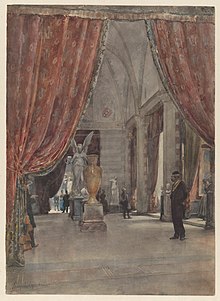
On the occasion of the opening of the Rijksmuseum Amsterdam , Jan Hoynck van Papendrecht, who later became known as a military painter, painted a watercolor of the gallery of honor , which he gave to the director of the Rijksmuseum, Frederik Obreen , as a gift. The night watch with Frans Banninck Cocq is shown in the background, mostly covered by a curtain . The watercolor was acquired from the art trade by the Rijksmuseum Amsterdam in 2002.
The bronze figure group The three-dimensional night watch (Dutch: Nachtwacht 3D or De Nachtwacht in drie dimensies ) by the Russian sculptors Michail Dronow and Alexander Taratynow was presented from 2006 to 2009 on the Rembrandtplein in Amsterdam. After several years of traveling to different locations, it has been permanently on the Rembrandtplein, right in front of the Rembrandt Monument, since 2012 .
- The night watch as a subject in the visual arts
Rembrandt's Studio , John Scarlett Davis , 1841, oil on canvas, Hereford Museum and Art Gallery
Tableaux vivants and flash mob
To mark the reopening of the renovated Rijksmuseum Amsterdam in April 2013 a group of actors led in a busy shopping center in Breda under the title Our heroes are back ( Dutch hero Onze zijn terug! ) A flash mob on. In the course of this, participants dressed up as figures of the night watch came running , took the appropriate postures and imitated the night watch behind a frame lowered from above . The art form supposedly created in the 21st century shows similarities with the tableaux vivants of the 19th century. At that time, associations of art lovers often organized scenic performances with which important paintings or other works of art were reproduced. In 1852, after the unveiling of the Rembrandt monument created by Louis Royer , a night watch was re- enacted in the Amsterdam theater , before Royer was crowned with a laurel wreath. The Hague Art Association Pulchri Studio performed on April 23, 1864, among other things, the Night Watch as Tableau vivant .
Movie and TV
- fiction
In the 1936 British feature film Rembrandt by Alexander Korda , with Charles Laughton in the title role, the plot initially builds on the production of the night watch and the rejection of the result by the client. The screenplay was written by Carl Zuckmayer and it was translated into English by Lajos Biró . The film shows a clipped replica of the painting from 1715.
The Franco-Swiss feature film Passion by Jean-Luc Godard , shot in 1982, shows a fictional film team recreating the scenes in a series of important paintings with actors who are filmed in three-dimensional space from different perspectives and with different lighting. One of the paintings depicted in this way is the Night Watch . The viewer can barely grasp the three-dimensional representation of the painting, since only excerpts of the picture are shown in short sequences, which alternate with scenes of a leading actress working in the factory.
In the 1995 television film The Rembrandt Connection , based on the spy novel Alistair MacLean's The Rembrandt Deal by Alistair MacNeill (as the completion of an unpublished manuscript by Alistair MacLean ), the protagonist played by Pierce Brosnan pursues the stolen Night Watch halfway around the world.
Peter Greenaway made The Night Watch in 2007 in his feature film Nightwatching - The Rembrandt Conspiracy the object of a criminal story about a conspiracy in the Amsterdam vigilante group. A year later, Rembrandt's Night Watch - Secrets of a Painting, a film called a documentary by Greenaway, appeared, in which he takes up the plot of the feature film and makes it the basis of supposed art-historical discussions.
- documentation
In November 1940, turned Andor of Barsy the documentary Rembrandt in the bunker ( Dutch Rembrandt in de schuilkelder ), which was completed in 1946 and the Flüchtung the vigil discussed and other art treasures during the Second World War.
In 2004, in the third season of the BBC series The Private Life of a Masterpiece, a fifty-minute documentary appeared in which, in addition to Gary Schwartz , Egbert Haverkamp-Begemann and Ernst van de Wetering, a number of other Rembrandt researchers and artists have their say.
Popular culture
- The Night Watch is a track on the 1974 album Starless and Bible Black by the progressive rock band King Crimson .
- The title The Shooting Company of Captain Frans B. Cocq can be found on the 2000 album Universal Migrator Part 1: The Dream Sequencer , the fourth album by the Dutch musician Arjen Lucassen in his Ayreon project . In the text of the song, the standard bearer describes the scene depicted in the night watch .
- The Night Watch (original title: Night Watch ) is the twenty-ninth Discworld novel by Terry Pratchett from 2002. The plot contains no reference to the Night Watch , but the cover designed by Paul Kidby is a parody of the painting. In place of the figure identified as Rembrandt's self-portrait, Kidby placed the portrait of his deceased colleague Josh Kirby , the back of the cover reproduces The Night's Watch unchanged.
- The Delft porcelain manufacturer De Porceleyne Fles , known internationally under the name Royal Delft , is showing a replica of the night watch consisting of 480 individual tiles in its company museum . The company also offers the image motif in a reduced size as a screen print and hand-painted.
- A large number of merchandising articles from the Rijksmuseum, the city of Amsterdam or other producers use the motif of the night watch or individual image details. These include puzzles , Playmobil figures, printed socks and other items of clothing, coffee cups and umbrellas.
Exhibitions (selection)
The Night Watch is a permanent part of the permanent exhibition at the Rijksmuseum Amsterdam. Due to its great importance for the Rijksmuseum, the city of Amsterdam and the Netherlands, as well as its sensitivity and large format, the painting will not be on loan. The following exhibition is therefore largely limited to exhibitions in the Rijksmuseum Amsterdam, in whose catalogs the Night Watch is listed.
- De Rembrandt tentoonstelling te Amsterdam (German: The Rembrandt Exhibition in Amsterdam ), Stedelijk Museum, September to November 1898, catalog no. 52
- Amsterdam in the loop of the eeuwen (German: Amsterdam in the course of the centuries ), Rijksmuseum Amsterdam, July 3 to September 15, 1925, catalog no. 576
- Weerzien der meesters in het Rijksmuseum (German: Reunion of the Old Masters in the Rijksmuseum ), Rijksmuseum Amsterdam, July 15 to September 30, 1945
- All Rembrandts , Rijksmuseum Amsterdam, February 15 to June 10, 2019
literature
- Harry Berger: Manhood, Marriage, and Mischief. Rembrandt's Night watch and other Dutch group portraits . Fordham University Press 2007, ISBN 978-0-8232-2556-9 .
- Egbert Haverkamp-Begemann : Rembrandt. The Nightwatch. Princeton: Princeton University Press 1982, ISBN 0-691-03991-7 .
- Willem Hijmans, Luitsen Kuiper, and Annemarie Vels Heijn: Rembrandt's Night Watch. Het vendel van Frans Banning Cooq, de geschiedenis van een schilderij. Leiden: Sijthoff 1976, ISBN 90-218-00160 .
- Alois Riegl : The Dutch group portrait . 2 volumes. Vienna: Österreichische Staatsdruckerei 1931. Text volume: digitized, Heidelberg University Library , table volume: digitized, Heidelberg University Library .
- Jochai Rosen: Soldiers at leisure. The guardroom scene in dutch genre painting of the Golden Age. Amsterdam: Amsterdam University Press 2010, ISBN 978-90-8964-204-2 .
- Stichting Foundation Rembrandt Research Project (ed.): A Corpus of Rembrandt Paintings. III. 1635-1642. Martinus Nijhoff, Dordrecht, Boston, London 1989, ISBN 978-94-010-6852-9 , Chapter A146 The Night Watch , pp. 430-485.
- Christian Tümpel : The Night Watch - Legend and Reality . In: the same, Rembrandt in self-testimonies and image documents . Rowohlt, Reinbek 1977, pp. 80-87, ISBN 3-499-50251-8 .
- Gabri Tussenbroek: Amsterdam en de Nachtwacht. De mannen op het meesterwerk van Rembrandt. Prometheus, Amsterdam 2018, ISBN 978-90-446-3858-5 .
- Samuel van Hoogstraten: Inleyding tot de hooge schoole der Schilderkonst . François van Hoogstraeten, Rotterdam 1678, digitized .
- Jürgen Müller: The Socratic artist. Studies on Rembrandt's Night Watch, Leiden: Brill 2015, pp. 226-308, ISBN 978-90-04-28525-5 .
Fiction
- Dick Walda: The Secret of the Night Watch. Translated from the Dutch by Andrea Marenzeller. Vienna: Jungbrunnen 2006, ISBN 3-7026-5778-9 (book for young people).
- Carl Zuckmayer: Rembrandt. A movie . Frankfurt / Main: Fischer 1980, ISBN 3-596-22296-6 (screenplay for the 1936 film).
Web links
- The Night Watch, Rembrandt van Rijn, 1642 , site of the Rijksmuseum Amsterdam
- The Night Watch in gigapixel resolution in the Google Art Project
Attacks and restorations
- De night watch. Hidden, vernield en devastated , Andere Tijden , April 6, 2017 (several videos on attacks and restorations, Dutch)
- De Nachtwacht onder 't mes about the attack in 1975 and the subsequent restoration (TV documentary ders Nederlandse Publieke Omroep , Dutch, 49 min.)
- Operation Night Watch , website of the Rijksmuseum Amsterdam, information and videos on the investigation and restoration 2019-2020
Flash mob
- Our heroes zijn terug! Flash mob on the occasion of the return of the Night Watch to the Rijksmuseum Amsterdam, April 2013, and the Onze helden zijn terug! (Making-of) to this (Dutch)
Individual evidence
- ↑ a b c d e f g Horst Gerson: Rembrandt. Painting. Complete works . Bertelsmann Kunstverlag Reinhard Mohn, Gütersloh 1969, chapter Die Nachtwache , p. 72–80 and catalog p. 338–339.
- ^ A b c SAC Dudok van Heel: Frans Banninck Cocq's Troop in Rembrandt's "Night Watch": The Identification of the Guardsmen. In: The Rijksmuseum Bulletin 2009, Volume 57, No. 1, pp. 42-87, JSTOR 40383630 .
- ↑ a b c Bas Kist: Een curieus militair tafereel . In: Kroniek van het Rembrandthuis 1988, Volume 40, No. 1, pp. 1-23, ISSN 0166-0381 .
- ↑ Caspar van Baerle: Blyde incomst the all-door brightest queen, Maria de Medicis, t'Amsterdam . Joan and Cornelis Blaeu , Amsterdam 1639, p. 13, digitized .
- ^ Stichting Foundation Rembrandt Research Project (ed.): A Corpus of Rembrandt Paintings. IV. The self-portraits . Springer, Dordrecht 2005, ISBN 1-4020-3280-3 , Chapter IV 3 'Self-portrait' , pp. 371–377.
- ↑ William Martin: Rembrandt zelf op de Nachtwacht . In: Oud Holland - Journal for Art of the Low Countries 1923, Volume 41, No. 1, pp. 1-4, doi: 10.1163 / 18750176-90000122 .
- ↑ Ernst van de Wetering: Rembrandts hidden zelfportretten. Rembrandt's Hidden Self-portraits . In: Kroniek van het Rembrandthuis 2002, No. 1-2, pp. 1-44, ZDB -ID 801386-X .
- ↑ a b c d e Marijke Kok: Rembrandt's Night Watch. Van feeststoet dead schuttersstuk . In: Bulletin van het Rijksmuseum 1967, Volume 15, No. 3, pp. 116-121, JSTOR 40381479 .
- ↑ a b c d Alois Riegl: The Dutch group portrait , pp. 169–282.
- ^ A b Paul Taylor: Darkness at Noon: Rembrandt's Night Watch . In: Kunstschrift. Openbaar kunstbezit 1994, Volume 6, pp. 22-27, ZDB -ID 807189-5 .
- ^ Samuel van Hoogstraten: Inleyding tot de hooge schoole der schilderkonst , p. 190.
- ^ Stichting Foundation Rembrandt Research Project (ed.): A Corpus of Rembrandt Paintings. I. 1625-1631 . Martinus Nijhoff, Den Haag, Boston, London 1982, ISBN 978-94-009-7519-4 , Chapter A 6 History painting (Subject unidentified) , pp. 104-113.
- ^ Stichting Foundation Rembrandt Research Project (ed.): A Corpus of Rembrandt Paintings. VI. Rembrandt's Paintings Revisited. A Complete Survey . Springer Science + Business Media, Dordrecht 2015, ISBN 978-94-017-9173-1 , Chapter 7 Rembrandt, History painting (subject still under discussion) , p. 482.
- ^ Stichting Foundation Rembrandt Research Project (ed.): A Corpus of Rembrandt Paintings. III. , P. 481.
- ↑ DC Meijer: Frans Banning Cocq en zijn family album . In: Eigen Haard 1906, No. 27 of July 7, pp. 426-430, digitized and No. 28 of July 14, pp. 444-447, digitized .
- ↑ No. 139. Inscription of the copy with water color after the night watch in the family album of the main character, Frans Banning Cocq . In: Cornelis Hofstede de Groot (ed.): The documents about Rembrandt (1575-1721) . The Hague, Martinus Nijhoff 1906, p. 163, digitized .
- ^ Stichting Foundation Rembrandt Research Project (ed.): A Corpus of Rembrandt Paintings. III. , P. 480.
- ↑ a b c d e f g h i Anonymous: De Restauratie van de Nachtwacht . In: Maandblad Amstelodamum 1946, Volume 33, pp. 75-78, PDF, 5.4 MB .
- ^ Wilhelm von Bode : The complete work of Rembrandt. History, description and heliographic reproduction of all the master's pictures, with a study of his life and his art. Fourth volume . Charles Sedelmeyer, Paris 1900, pp. 96–98, work no. 255, digitized .
- ↑ Cornelis Hofstede de Groot : Descriptive and critical directory of the works of the most outstanding Dutch painters of the XVII. Century. Sixth volume. Paul Neff, Esslingen and F. Kleinberger, Paris 1915, digitized version, Heidelberg University Library , work No. 926.
- ↑ Abraham Bredius : Rembrandt. Schilderijen. W. de Haan, Utrecht 1935, digitized version, Heidelberg University Library . German: Rembrandt. Painting. Phaidon-Verlag, Vienna 1935. English: The Paintings of Rembrandt. London 1937, Plant No. 410.
- ^ A b c Harry Berger: The 'Night Watch' as homosocial pastoral . In: Manhood, Marriage, and Mischief. Rembrandt's Night watch and other Dutch group portraits . Fordham University Press 2007, pp. 177-225 and Notes pp. 257-265, ISBN 978-0-8232-2556-9 .
- ↑ De Nachtwacht, Rembrandt van Rijn, 1642 , Rijksmuseum Amsterdam, accessed on 23 September 2019.
- ↑ Amsterdammers gratis naar hun Nachtwacht , Municipality of Amsterdam, September 4, 2019, accessed on September 22, 2019.
- ↑ a b c Ann Jensen Adams: Civic guard portraits: private interests and the public sphere . In: Netherlands Yearbook for History of Art / Nederlands Kunsthistorisch Jaarboek Online 1995, Volume 46, No. 1, 168–197, doi: 10.1163 / 22145966-90000131 .
- ^ Alois Riegl: The Dutch group portrait , pp. 7–39.
- ↑ Alois Riegl: The Dutch group portrait , pp. 40-108.
- ↑ Alois Riegl: The Dutch group portrait , pp. 109–168.
- ^ Samuel van Hoogstraten: Inleyding tot de hooge schoole der schilderkonst , p. 176.
- ↑ Joshua Reynolds: The literary works of Sir Joshua Reynolds, vol. 2 . T. Cadell, London 1835, p. 197, digitized .
- ↑ a b Benjamin Binstock: Postscript. Alois Riegl in the Presence of 'The Nightwatch' . In: October 1995, Volume 74, pp. 36-44, doi: 10.2307 / 778819 .
- ^ Conrad Busken Huet: Het land van Rembrand. Studies over de noordnederlandsche beschaving in de zeventiende eeuw , Volume 2. Tjeenk Willink & Zoon, Haarlem 1901, p. 192, digitized .
- ^ Johan Huizinga: Dutch Culture of the Seventeenth Century. Your social foundations and national characteristics. Three lectures for the German-Dutch Institute Cologne, given in January 1932 . Diederichs, Jena 1933, p. 51f.
- ↑ Christian Tümpel: The Night Watch - Legend and Reality , p. 84.
- ↑ a b Anonymus: De Nachtwacht . In: Maandblad Amstelodamum 1947, Volume 34, pp. 69-71, PDF, 4.8 MB .
- ↑ a b c d De Nachtwacht. Hidden, vernield en devastated , Andere Tijden , April 6, 2017, accessed September 24, 2019.
- ↑ a b c Jochen Becker: 'Ons Rijksmuseum wordt een tempel': on the iconography of the Amsterdam Rijksmuseum ' . In: Netherlands Yearbook for History of Art / Nederlands Kunsthistorisch Jaarboek Online 1984, Volume 35, No. 1, pp. 227–326, doi: 10.1163 / 22145966-90000587
- ↑ Jan Jacob de Gelder: Bartholomeus van der Helst . Brusse, Utrecht 1921, also dissertation, Utrecht University, pp. 96–98, digitized version .
- ↑ a b c d Pieter van Os: Zo zwierf de Nachtwacht , nrc.next , March 26, 2013, accessed on September 29, 2019.
- ↑ a b c d Jan Frederik Heijbroek: De Nachtwacht op reis. Een beeldverslag . In: Bulletin van het Rijksmuseum 2003, Volume 51, No. 3, pp. 275-283, JSTOR 40383561 .
- ↑ a b John Heideman: De Kunstkelder in Castricum , website Duinenenmensen.nl, accessed on September 29, 2019.
- ↑ a b c Niek Kaan: Night watch in het Geversduin . In: Jaarboek Oud-Castricum 2008, Volume 31, pp. 19-28.
- ^ Pieter JJ van Thiel, CJ de Bruyn Kops and Wouter Kloek: Ninety-six Original Dutch Framings . In: Pieter JJ van Thiel and CJ de Bruyn Kops (eds.): Framing in the Golden Age. Prijst de Lijst . Waanders, Zwolle 1995, ISBN 90-6630-278-X , pp. 95-362, catalog no. 33.
- ↑ a b c Martjan Kuit: De lijstengeschiedenis van De Nachtwacht . Martjan Kuit website, July 14, 2017, accessed September 30, 2019.
- ^ Pieter JJ van Thiel, CJ de Bruyn Kops and Wouter Kloek: Ninety-six Original Dutch Framings . In: Pieter JJ van Thiel and CJ de Bruyn Kops (eds.): Framing in the Golden Age. Prijst de Lijst . Waanders, Zwolle 1995, ISBN 90-6630-278-X , pp. 95-362, catalog no. 33.
- ^ Fritz Bürger: The Gensler, three Hamburg painters brothers . Strasbourg: Heitz & Mündel 1916, p. 16, digitized .
- ↑ a b Rembrandt, Civic guardsmen of Amsterdam under command of Banninck Cocq, 1642 gedateerd on the website of the RKD - Nederlands Instituut voor Kunstgeschiedenis , accessed on September 15, 2019.
- ↑ Anonymous: 'The Night Watch' Restored . In: The Burlington Magazine 1976, Volume 118, No. 884, pp. 731 and 781, JSTOR 878586 .
- ^ Vandalized Rembrandt To Go Back on Display , The New York Times , April 28, 1990.
- ↑ Nikolas Fischer: Rembrandt's “Night Watch” is being restored. Deutsche Welle, July 8, 2019, accessed on July 8, 2019 (German).
- ^ Rijksmuseum Amsterdam: Operation Night Watch to start at the Rijksmuseum , October 1, 2019, accessed on December 12, 2019.
- ^ Peter JJ van Thiel: Het Rijksmuseum in het Trippenhuis, 1814–1885 (IV): Copyists and photographers . In: Bulletin van het Rijksmuseum 1982, Volume 30, No. 1, pp. 63-86, JSTOR 40382053 .
- ↑ Vera de Lange: Rembrandt in de schuilkelder , EYE Filmmuseum website , March 15, 2015, accessed on September 28, 2019.


